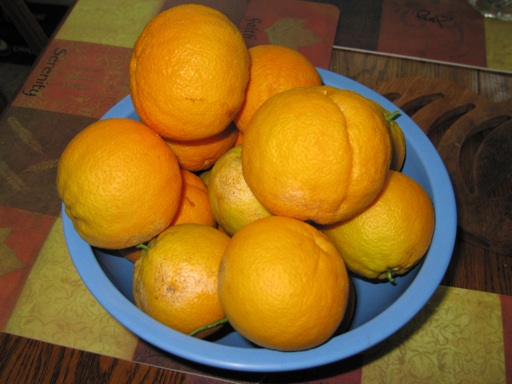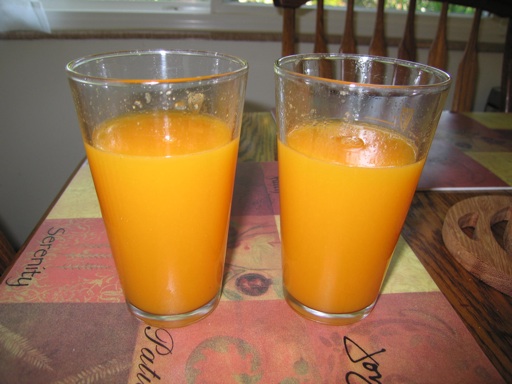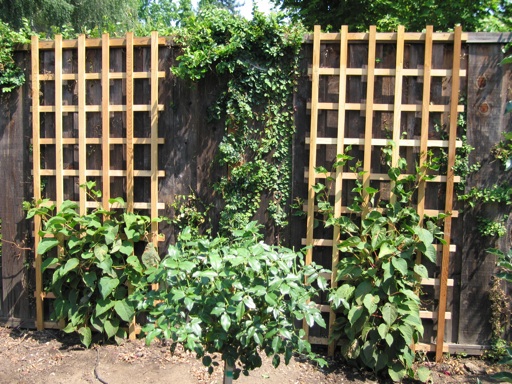


The house we live in came with mature valencia and navel orange bushes. The navel oranges ripen in the spring. The valencia oranges ripen in the summer, right in the middle of the fruit season for so many other plants we have growing in our yard. Because we are so busy eating other fruits, we often leave many of our valencia oranges on the bush for months after they are ready to pick. Valencia oranges can hang on the branches for months after they are ripe without losing quality or rotting. Sometimes I leave some of the fruit on the bush until October early November.
Our valencia bush typically produces over 100 fruits each year. This year it has about 200 oranges. They are good for eating fresh, although they are not as tasty and sweet as the navel oranges. We use most of our valencias to make fresh squeezed orange juice, which is so good. I usually add a teaspoon or two of sugar to each glass to make it extra sweet. I squeezed about 8 oranges to make the two glasses in the bottom picture.
Oranges are tricky plants to get established. In order to get oranges to thrive, they need lots of nitrogen rich fertilizer, applied in the late winter and spring. And in my opinion, they also need regular watering.
I have planted several oranges, because I wanted to try new varieties, and because I wanted another navel. Most of the young oranges I planted have died. Several of the young oranges I planted died as soon as their root balls dried out in the summer. The mature oranges we have are better able to tolerate dry periods than the recently planted oranges. My theory on oranges is to keep them well-fed and well-watered, just not saturated or water logged. I have read many posts on other sites claiming that oranges like to dry out between waterings. That technique has never worked for me.
August 09 2009 | Oranges | Comments Off on Valencia Orange Juice

I planted male and female kiwifruit plants along the fence in our backyard last spring. I like the taste of store bought kiwifruit, and I thought it would be fun to grow our own. I have also heard that home grown kiwifruit tastes better than the store bought ones.
I selected a female kiwifruit variety called Vincent, because that was the only variety being sold in our local nurseries, and a male variety selected to pollinate a Vincent female. You need to have a male plant to pollinate the female, or the female won’t set fruit.
I used to think that kiwifruit was a tropical plant that required a tropical climate to grow and produce fruit. I found out only last year that it is a temperate climate plant that requires at least a few hundred hours of chill (i.e., below 45 degrees F) each winter to stimulate fruit production.
After doing some research into kiwifruit, I have learned that it is a vigorous grower that requires a sturdy support system for its vines and fruits. Apparently, a mature female kiwifruit plant can produce hundreds of pounds of fruit each year. Most commercial growers use T-shaped trellises or pergolas to support kiwifruits. Many home growers train kiwifruits to grow up an arbor.
I decided instead to use a smaller support system that would take up less space than an arbor or T-trellis. Last weekend, I nailed one wooden grid-shaped trellis to our fence behind each kiwi plant, as shown in this picture. The male plant is on the left, and the female plant is on the right. My plan is to prune both plants severely a few times a year to keep them within the bounds of these support structures.
I don’t want to get hundreds of pounds of fruit each year. About 20-30 pounds would be enough. It seems that these trellises would be large enough to support about that much fruit. I am just hoping that it will be manageable to keep the vines confined within this area as they mature.
August 09 2009 | Kiwifruit | Comments Off on Kiwifruit on Trellis



